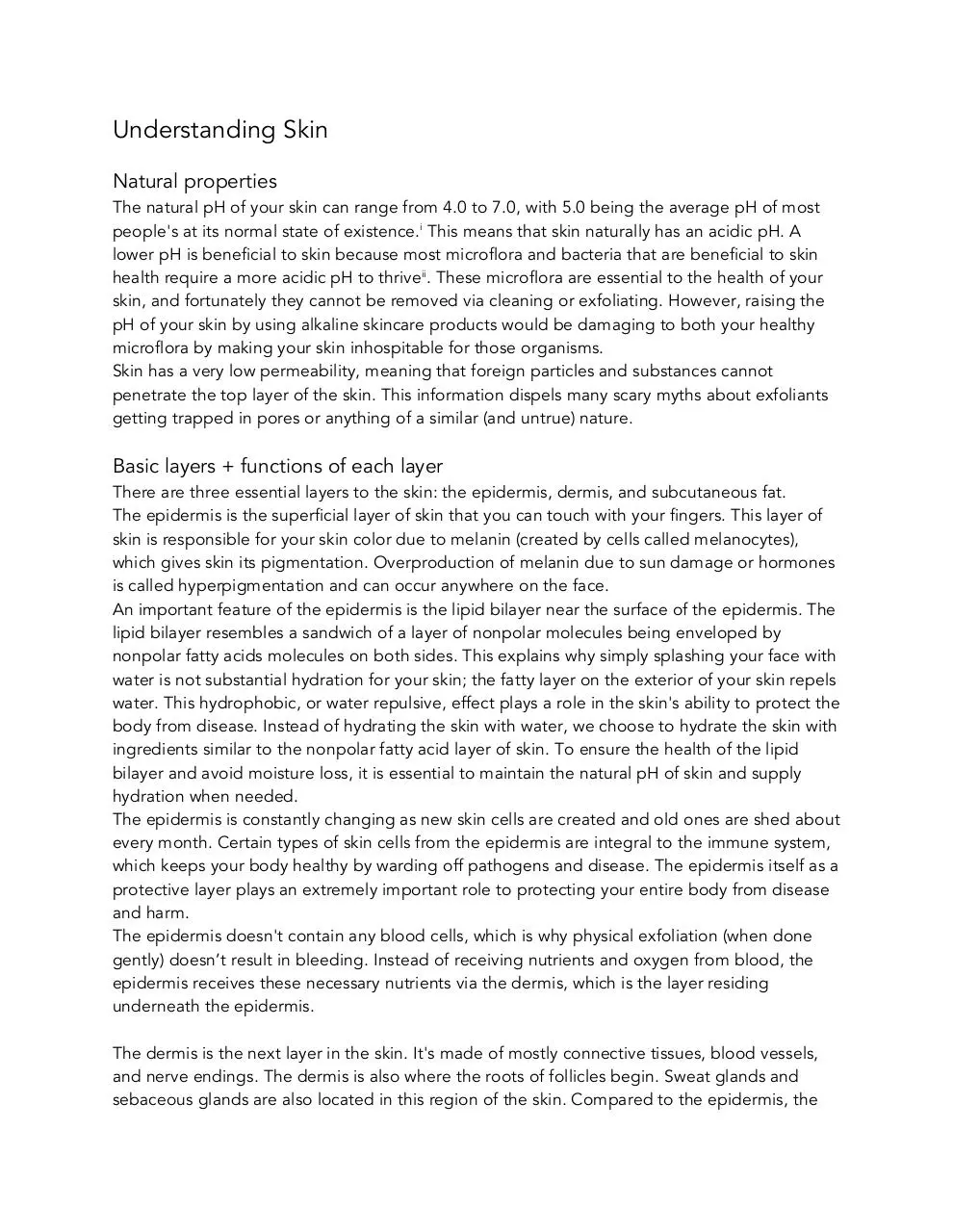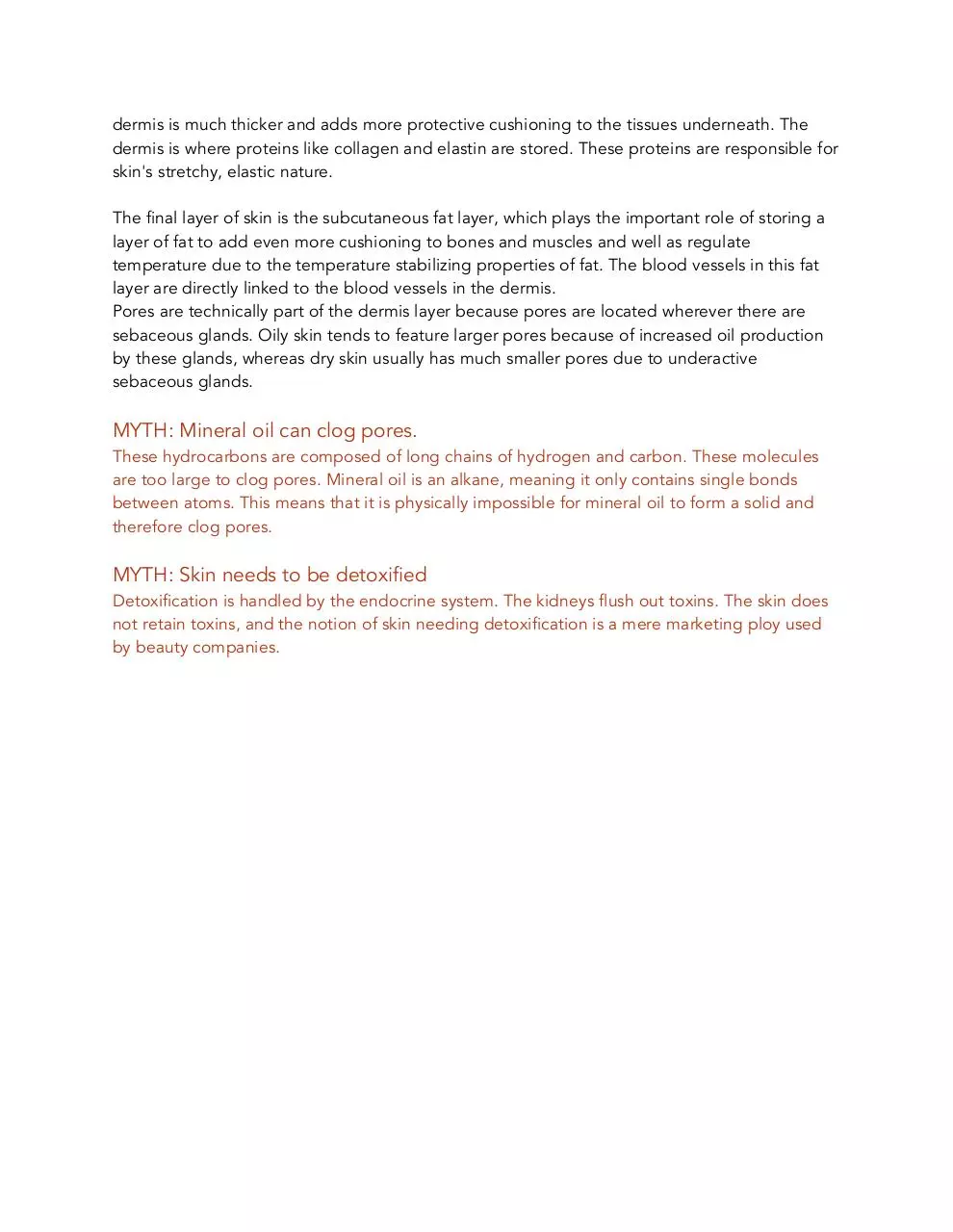crash course skincare (PDF)
File information
Title: Microsoft Word - crash course skincare.docx
This PDF 1.3 document has been generated by Word / Mac OS X 10.10.4 Quartz PDFContext, and has been sent on pdf-archive.com on 28/08/2015 at 03:59, from IP address 128.62.x.x.
The current document download page has been viewed 515 times.
File size: 103.06 KB (10 pages).
Privacy: public file





File preview
Introduction
Grab a cup of tea and a snack because you're about to receive a crash course in
skincare. In this fun PDF, I'll teach you about why skincare matters, how the skin's
biology operates, some basic biochemistry, signs of distress and how to alleviate them,
and some essential information on anti aging. I compiled this information from
knowledge garnered from my classes in university as a double major in chemical
engineering and chemistry, as well as information I've learned from scientific articles
published by organizations such as the National Institute of Health. My goal is to
educate you in the simplest terms possible about what's true and what's not; the
internet is full of misinformation and faulty arguments regarding skincare. As you'll
learn in the first chapter, the health of your skin should be a priority, and the first step
to achieving that is educating yourself. I can assure you that the information in this
document is all 100% verified and supported by medical evidence and academic texts.
Why skincare matters
Skin is the largest organ on your body
The skin as an organ does far more than cover the body: it protects the body from disease and
parasites. Healthy, hydrated skin is more effective at preventing infection than compromised
skin. In this case, infection includes acne.
Skin health indicates the health of other tissues
Conversely, your skin is the first place where symptoms of illness occur. Dehydration from
being sick with a cold may not be apparent until you notice dry patches on your face. A
hormonal imbalance may be undetectable expect for persisting painful acne and excessive hair
growth. Monitoring how your skin looks and feels is often the first step to gauging your health.
Be perceptive of how your skin feels when you're healthy and full of energy versus how your
skin feels when you're feeling under the weather or under a lot of stress.
MYTH: Acne is a superficial skin disease that can easily be cured
Acne can actually be indicative of serious medical issues, such as polycystic ovarian syndrome.
Chronic acne can be seriously damaging to one's skin and self esteem. Even if you have the
most state of the art skincare routine and healthiest diet, chronic acne can still persist because
the true cause of the acne has not been eliminated. Sometimes acne isn't really your fault!
When dealing with troubling acne, it is always a good idea to consult your doctor or
dermatologist for their professional opinion. When left untreated, acne causes serious scarring
that may be permanent, so it's best to treat it early instead of waiting.
Healthy Skin Will Take Care of You
When you invest the time and energy into properly caring for your skin, your healthy skin will
reward you! You may find yourself spending less money on expensive foundations and
concealers used on a daily basis. Instead you can put that money (which definitely adds up
over the course of a year) towards things of more positive influence on your life like a fun
hobby or your education. Maybe you have more time to sleep in the morning because you no
longer feel the need to wear foundation every day. As you'll learn in later chapter, healthy skin
starting at a young age means delaying the natural aging process of developing fine lines and
losing elasticity.
Learning how to take of your skin can offer a new perspective of self care for your nighttime
and morning routines. Learning to take care of your wellness can start by being more conscious
of how you treat your skin, and in turn you may develop a more self aware attitude of how you
treat the rest of your body.
Knowing how to take of your skin will eliminate the stress of not knowing how to handle a bad
breakout or unusual redness and texture. Of course, consulting a doctor is the best way to
determine the cause and prescribe treatment for a skin condition, but basic knowledge about
skin biology and biochemistry can carry you throughout everyday life while still giving you
results.
Understanding Skin
Natural properties
The natural pH of your skin can range from 4.0 to 7.0, with 5.0 being the average pH of most
people's at its normal state of existence.i This means that skin naturally has an acidic pH. A
lower pH is beneficial to skin because most microflora and bacteria that are beneficial to skin
health require a more acidic pH to thriveii. These microflora are essential to the health of your
skin, and fortunately they cannot be removed via cleaning or exfoliating. However, raising the
pH of your skin by using alkaline skincare products would be damaging to both your healthy
microflora by making your skin inhospitable for those organisms.
Skin has a very low permeability, meaning that foreign particles and substances cannot
penetrate the top layer of the skin. This information dispels many scary myths about exfoliants
getting trapped in pores or anything of a similar (and untrue) nature.
Basic layers + functions of each layer
There are three essential layers to the skin: the epidermis, dermis, and subcutaneous fat.
The epidermis is the superficial layer of skin that you can touch with your fingers. This layer of
skin is responsible for your skin color due to melanin (created by cells called melanocytes),
which gives skin its pigmentation. Overproduction of melanin due to sun damage or hormones
is called hyperpigmentation and can occur anywhere on the face.
An important feature of the epidermis is the lipid bilayer near the surface of the epidermis. The
lipid bilayer resembles a sandwich of a layer of nonpolar molecules being enveloped by
nonpolar fatty acids molecules on both sides. This explains why simply splashing your face with
water is not substantial hydration for your skin; the fatty layer on the exterior of your skin repels
water. This hydrophobic, or water repulsive, effect plays a role in the skin's ability to protect the
body from disease. Instead of hydrating the skin with water, we choose to hydrate the skin with
ingredients similar to the nonpolar fatty acid layer of skin. To ensure the health of the lipid
bilayer and avoid moisture loss, it is essential to maintain the natural pH of skin and supply
hydration when needed.
The epidermis is constantly changing as new skin cells are created and old ones are shed about
every month. Certain types of skin cells from the epidermis are integral to the immune system,
which keeps your body healthy by warding off pathogens and disease. The epidermis itself as a
protective layer plays an extremely important role to protecting your entire body from disease
and harm.
The epidermis doesn't contain any blood cells, which is why physical exfoliation (when done
gently) doesn’t result in bleeding. Instead of receiving nutrients and oxygen from blood, the
epidermis receives these necessary nutrients via the dermis, which is the layer residing
underneath the epidermis.
The dermis is the next layer in the skin. It's made of mostly connective tissues, blood vessels,
and nerve endings. The dermis is also where the roots of follicles begin. Sweat glands and
sebaceous glands are also located in this region of the skin. Compared to the epidermis, the
dermis is much thicker and adds more protective cushioning to the tissues underneath. The
dermis is where proteins like collagen and elastin are stored. These proteins are responsible for
skin's stretchy, elastic nature.
The final layer of skin is the subcutaneous fat layer, which plays the important role of storing a
layer of fat to add even more cushioning to bones and muscles and well as regulate
temperature due to the temperature stabilizing properties of fat. The blood vessels in this fat
layer are directly linked to the blood vessels in the dermis.
Pores are technically part of the dermis layer because pores are located wherever there are
sebaceous glands. Oily skin tends to feature larger pores because of increased oil production
by these glands, whereas dry skin usually has much smaller pores due to underactive
sebaceous glands.
MYTH: Mineral oil can clog pores.
These hydrocarbons are composed of long chains of hydrogen and carbon. These molecules
are too large to clog pores. Mineral oil is an alkane, meaning it only contains single bonds
between atoms. This means that it is physically impossible for mineral oil to form a solid and
therefore clog pores.
MYTH: Skin needs to be detoxified
Detoxification is handled by the endocrine system. The kidneys flush out toxins. The skin does
not retain toxins, and the notion of skin needing detoxification is a mere marketing ploy used
by beauty companies.
Acids and Bases
The most basic definition of an acid and a base are proton donors and proton acceptors
respectively according to the Bronsted-Lowry Definition. The measure of acidity of basicity of a
substance is defined by equilibrium constants, which in our case is called a pKa value. A pKa
value refers to the ratio of undissociated ions to undissociated ions when the substance is
added to water. As a general rule, a large pKa signifies a weak acid, whereas a small pKa
signifies a strong acid. For example, the pKa of acetic acid (which is also called vinegar) is 4.76.
This means that acetic acid is a weak acid because it does not readily dissociate in water. When
acetic acid is added to water, there are more acetic acid ions present than dissociated acetate
and hydronium (H3O+) ionsiii .
The term pH is used to describe the concentration of hydrogen ions in a solution. The pH scale
is logarithmic, meaning that each value is a value of ten. For example, a pH of 5 is ten times
more acidic than a pH of 6, and a pH of 4 is one hundred times more acidic than a pH of 6.
Skin in Distress
Common ingredients to avoid
There are certain ingredients that are unfortunately commonplace in many skincare products
and home remedies. Some of them include:
• Apple cider vinegar
• Sugar
• Lemon
• Cinnamon
• Denatured alcohol
• Isopropyl alcohol
• Ethyl alcohol
• Sodium hydroxide (this ingredient is fine when used in conjunction with an acid as
commonly seen in acne medication)
• Sodium lauryl sulfate
• Olefin sulfonate
• Most fragrant essential oils (bergamot, lavender, eucalyptus, mint, citrus, etc)
• Fragrance (often called “parfum” in ingredient lists)
• Toothpaste
• Baking soda
• Extremely hot water
• Extremely hot steam
• Anything very alkaline or very acidic
Truthfully, most home remedies or masks made from ingredients found in the kitchen should
be completely avoided as a general rule. There are a handful of home remedies that are
beneficial (such as using dark honey on acne), but I recommend avoiding them to minimize any
accidental damage.
Signs of skin distress
There are four cardinal inflammation signs: rubor, tugor, dolor, and calor.iv These translate from
Latin to redness, swelling, pain, and heat. Any time injury occurs to the body, a combination of
these inflammation signs appear as the immune system does damage control and begins the
healing process. When you put a new product on your face and any of these signs appear, it’s
advisable to wash off the product immediately. Skincare products (or makeup) should not burn
or cause redness. These symptoms are the body's way of telling you that something in that
product is irritating the skin badly and needs to be removed as soon as possible! Ignoring the
body's immune response only leads to skin damage.
Acne
Most people know that if a skincare product or makeup product causes a breakout, it's best to
discontinue usage. However, there's a strange misconception that a breakout arising after
doing a clay mask means that the mask is drawing out impurities and causing a breakout,
therefore doing its job. This is entirely incorrect and actually harmful information to spread. No
product when working correctly should cause a breakout. Clay masks should not cause
breakouts. A breakout is not normal and indicates the product containing irritating ingredients.
Other signs of distress include abnormal dry patches, excessive oiliness, and peeling.
MYTH: Oily skin needs to be dried out
On the contrary, oily skin is a natural state of existence for some people's skin! Altering the
skin's natural oiliness can trigger detrimental effects. If you have naturally oily skin, focus on
gently moisturizing your skin to try to coax your skin into producing less oil instead of trying to
aggressively dry it out. Drying out your skin may cause your skin to begin overproducing oil to
compensate for its dehydration. The goal is to have hydrated skin, and while excessively oily
skin can be problematic, manageable oily skin is nothing to worry about. Instead of trying to
dry out your oily skin, find makeup products that control shine and mattify if you desire a less
oily appearance. Attempting to dry out oily skin does damage to the lipid bilayer of the skin.
Many people with very dry skin would do anything to have naturally luminous skin! Oily skin
also tends to show signs of aging less quickly than dry skin.
How to alleviate symptoms
Play detective and look at products you've applied to your skin or foods you've eaten within
the past few hours. Sometimes food induced allergic reactions can manifest on the surface of
the skin. Otherwise, examine any new products you've used on your skin (including your hands)
and eliminate new products for a few days to see if symptoms improve. To make skincare
damage control less complicated, I recommend introducing new skincare products one at a
time spaced out several weeks apart.
If one area of your face is extremely irritated and uncomfortable or even painful, using a cold
compress can help alleviate the discomfort. Introducing a cold sensation to the area will
counteract any swelling or heat generated by the inflammation process. Be sure to apply a thin
towel between skin and cold compress.
Of course, consult a doctor if symptoms do not get better or if symptoms get worse after 24
hours
Anti Aging
The most effective way to prevent signs of aging is preventative measures well before signs of
aging begin to appear. As a general rule, the best age to begin anti aging measures is the mid
to late twenties.
Anti Aging Measures to Take Now
Wearing SPF diligently: This means wearing a sunscreen of SPF of 30 or higher that protects
against both UVA and UVB rays every single day. In a best case scenario, this means staying
out of the sun completely, but seeing that this is unrealistic for most people, wearing a hat that
covers the face and neck whenever possible and wearing a good sunscreen is the next best
option. UV rays from the sun contribute greatly to deterioration of skin health and appearance
including decreased collagen production, hyperpigmentation, and cancerous melanomav.
Stop smoking: Smoking is a huge risk factor for any disease, and it even speeds up natural
processes like aging on the skin. Smoking contributes to more prominent wrinkles, areas of
hyperpigmentation on the face, and decreased collagen production, which leads to sagging of
the skinvi.
Start good habits: Good skincare habits include washing your face twice daily with a gentle
cleanser, moisturizing, and protecting skin from UV rays. It's not necessary to begin using
powerful retinol products starting on your 20th birthday, but it is a good idea to incorporate
some antioxidant moisturizers or toners into your skincare routine. More beneficial ingredients
appropriate for any adult include retinolvii, sodium hyaluronateviii, hyaluronic acid, peptides,
polysaccharides, and proteins. All of these ingredients are called "skin identical" because your
skin naturally produces these molecules, and adding extra molecules helps the skin to maintain
its health.
MYTH: People with dark skin don't need to wear SPF
UV rays emitted from the sun don't racially discriminateix. All biological functions of the skin are
universal regardless of skin color. While some ethnic groups may be more predisposed to
certain skin types and diseases, excessive exposure to UV rays always cause a cytotoxic, or cell
killing, effect in the epidermis layer of the skin. UV rays also cause mutations in cells that can
lead to melanoma or skin cancer. Wearing an SPF 30 every day is a very easy way to prevent a
potentially deadly disease from developing later in life.
MYTH: Retinol causes aging
This is a common misconception that can attributed to retinol's tendency to cause a
heightened sensitivity to sun. Either way, you should be wearing SPF every day, rain or shine,
and this heightened sensitivity to sunlight should not be a cause for concern.
Download crash course skincare
crash course skincare.pdf (PDF, 103.06 KB)
Download PDF
Share this file on social networks
Link to this page
Permanent link
Use the permanent link to the download page to share your document on Facebook, Twitter, LinkedIn, or directly with a contact by e-Mail, Messenger, Whatsapp, Line..
Short link
Use the short link to share your document on Twitter or by text message (SMS)
HTML Code
Copy the following HTML code to share your document on a Website or Blog
QR Code to this page

This file has been shared publicly by a user of PDF Archive.
Document ID: 0000298352.